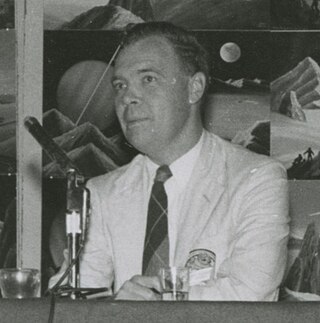
Harry Clement Stubbs, better known by the pen name Hal Clement, was an American science fiction writer and a leader of the hard science fiction subgenre. He also painted astronomically oriented artworks under the name George Richard.

James Benjamin Blish was an American science fiction and fantasy writer. He is best known for his Cities in Flight novels and his series of Star Trek novelizations written with his wife, J. A. Lawrence. His novel A Case of Conscience won the Hugo Award. He is credited with creating the term "gas giant" to refer to large planetary bodies.

John Wood Campbell Jr. was an American science fiction writer and editor. He was editor of Astounding Science Fiction from late 1937 until his death and was part of the Golden Age of Science Fiction. Campbell wrote super-science space opera under his own name and stories under his primary pseudonym, Don A. Stuart. Campbell also used the pen names Karl Van Kampen and Arthur McCann. His novella Who Goes There? was adapted as the films The Thing from Another World (1951), The Thing (1982), and The Thing (2011).

Orphans of the Sky is a science fiction novel by American writer Robert A. Heinlein (1907–1988), consisting of two parts: "Universe" and its sequel, "Common Sense". The two novellas were first published together in book form in 1963. "Universe" was also published separately in 1951 as a 10¢ Dell paperback. The work presents one of the earliest fictional depictions of a generation ship.
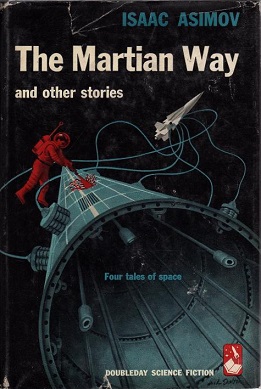
The Martian Way and Other Stories is a 1955 collection of four science fiction stories (3 novelettes and one novella by American writer Isaac Asimov, previously published in 1952 and 1954. Although single-author story collections generally sell poorly, The Martian Way and Other Stories did well enough that Doubleday science fiction editor Walter I. Bradbury was willing to publish a second collection, Earth Is Room Enough, in 1957.
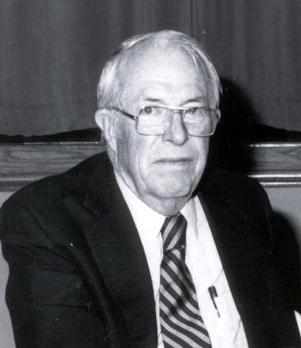
John Stewart Williamson, who wrote as Jack Williamson, was an American science fiction writer, one of several called the "Dean of Science Fiction". He is also credited with one of the first uses of the term genetic engineering. Early in his career he sometimes used the pseudonyms Will Stewart and Nils O. Sonderlund.

The Naked Sun is a science fiction novel by American writer Isaac Asimov, the second in his Robot series. Like its predecessor, The Caves of Steel, this is a whodunit story. It was first published in book form in 1957 after being serialized in Astounding Science Fiction between October and December 1956.
In American science fiction of the 1950s and '60s, psionics was a proposed discipline that applied principles of engineering to the study of paranormal or psychic phenomena, such as extrasensory perception, telepathy and psychokinesis. The term is a blend word of psi and the -onics from electronics. The word "psionics" began as, and always remained, a term of art within the science fiction community and—despite the promotional efforts of editor John W. Campbell, Jr.—it never achieved general currency, even among academic parapsychologists. In the years after the term was coined in 1951, it became increasingly evident that no scientific evidence supports the existence of "psionic" abilities.

A Case of Conscience is a science fiction novel by American writer James Blish, first published in 1958. It is the story of a Jesuit who investigates an alien race that has no religion yet has a perfect, innate sense of morality, a situation which conflicts with Catholic teaching. The story was originally published as a novella in 1953, and later extended to novel-length, of which the first part is the original novella. The novel is the first part of Blish's thematic After Such Knowledge trilogy and was followed by Doctor Mirabilis and both Black Easter and The Day After Judgment.
The Golden Age of Science Fiction, often identified in the United States as the years 1938–1946, was a period in which a number of foundational works of science fiction literature appeared. In the history of science fiction, the Golden Age follows the "pulp era" of the 1920s and 1930s, and precedes New Wave science fiction of the 1960s and 1970s. The 1950s are, in this scheme, a transitional period. Robert Silverberg, who came of age then, saw the 1950s as the true Golden Age.
"Not Final!" is a science fiction short story by American writer Isaac Asimov, originally published in the October 1941 issue of Astounding Science Fiction, and included in the 1972 collection The Early Asimov. Its sequel, "Victory Unintentional", is a robot story. These are two of the few stories by Asimov to postulate non-human intelligences in the Solar system.
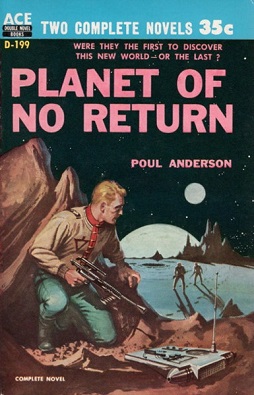
Question and Answer is a science fiction novel by American writer Poul Anderson. It originally appeared in the June and July 1954 issues of magazine Astounding Science Fiction, and was later reprinted in 1956 as part of Ace Double D-199 under the title Planet of No Return, and again as a stand-alone Ace novel in February 1978 under the original title.
Pantropy is a hypothetical process of space habitation or space colonization in which, rather than terraforming other planets or building space habitats suitable for human habitation, humans are modified to be able to thrive in the existing environment. The term was coined by science fiction author James Blish, who wrote a series of short stories based on the idea.

The Psychotechnic League is a future history created by American science fiction writer Poul Anderson. The name "Psychotechnic League" was invented by Sandra Miesel during the early 1980s, to capitalize on Anderson's better-known Polesotechnic League future history. Anderson published 21 novels, novellas and short stories set in this future between 1949 and 1957, with a 22nd published in 1968.
"Surface Tension" is a science fiction short story by American writer James Blish, originally published in the August 1952 of Galaxy Science Fiction. As collected in Blish's The Seedling Stars, it was revised to incorporate material from his earlier story "Sunken Universe", published in Super Science Stories in 1942.
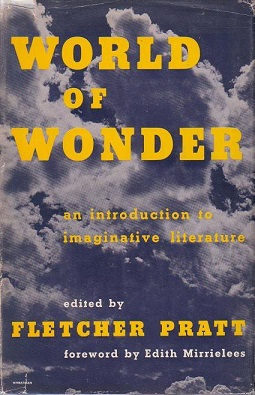
World of Wonder is an anthology of science fiction and fantasy stories edited by Fletcher Pratt, published in hardcover by Twayne in 1951. No subsequent editions were issued.

Two Complete Science-Adventure Books was an American pulp science fiction magazine, published by Fiction House, which lasted for eleven issues between 1950 and 1954 as a companion to Planet Stories. Each issue carried two novels or long novellas. It was initially intended to carry only reprints, but soon began to publish original stories. Contributors included Isaac Asimov, Robert A. Heinlein, Arthur C. Clarke, Poul Anderson, John Brunner, and James Blish. The magazine folded in 1954, almost at the end of the pulp era.

The Best of Astounding: Classic Short Novels from the Golden Age of Science Fiction is an anthology of science fiction short works edited by James Gunn. It was first published in hardcover by Carroll & Graf in August 1992.
The Miracle-Workers is a science fiction novella by Jack Vance published in 1958. It was first published in Astounding Science Fiction in the July 1958 edition. It is about humans on an Earth-like planet which was colonized by space travellers many centuries ago. In the intervening years, the inhabitants have lost their understanding of science and have regressed to a Medieval state of technology, aided by their use of voodoo, telepathy, and magic. Change is set in motion when a maverick apprentice Jinxman starts to rediscover the scientific method and learn about science.
The year 1957 was marked, in science fiction, by the following events.












